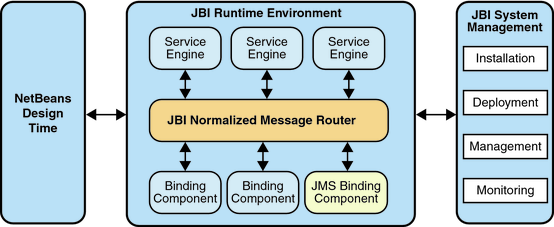| Skip Navigation Links | |
| Exit Print View | |

|
Oracle Java CAPS JMS Binding Component User's Guide Java CAPS Documentation |
| Skip Navigation Links | |
| Exit Print View | |

|
Oracle Java CAPS JMS Binding Component User's Guide Java CAPS Documentation |
Using the JMS Binding Component
JMS Binding Component Features
JMS Binding Component Scenarios
Outbound InOut Exchange Scenario
Inbound InOut Exchange Scenario
Creating JMS-Based Concrete WSDL Documents
To Create a JMS-Based Concrete WSDL Document from the New WSDL Document Wizard
To Create a JMS-Based Concrete WSDL Document from the New File Wizard
Request Connection Configuration
Request Consumer Configuration
Request Publisher Configuration
Response Destination Configuration
Response Consumer Configuration
Response Publisher Configuration
Specifying the Protocol, Server, and Port
Connecting to the JMS Server Using JNDI
Configuring Redelivery Handling
Configuring Redelivery Handling from the Wizard
Configuring Redelivery Handling by Editing the WSDL Document
Using the Normalized Message Properties
Inbound Normalized Message Properties
Connection URL Property (org.glassfish.openesb.jms.inbound.connectionurl)
User Name Property (org.glassfish.openesb.jms.inbound.username)
Message Selector Property (org.glassfish.openesb.jms.inbound.messageselector)
Destination Property (org.glassfish.openesb.jms.inbound.destination)
Destination Type Property (org.glassfish.openesb.jms.inbound.destinationtype)
Forward As Attachment Property (org.glassfish.openesb.jms.inbound.forwardasattachment)
Outbound Normalized Message Properties
Connection URL Property (org.glassfish.openesb.jms.outbound.connectionurl)
User Name Property (org.glassfish.openesb.jms.outbound.username)
Password Property (org.glassfish.openesb.jms.outbound.password)
Destination Property (org.glassfish.openesb.jms.outbound.destination)
Destination Type Property (org.glassfish.openesb.jms.outbound.destinationtype)
XA Transaction Property (org.glassfish.openesb.jms.outbound.xatransaction)
Delivery Mode Property (org.glassfish.openesb.jms.outbound.deliverymode)
Timeout Property (org.glassfish.openesb.jms.outbound.timeOut)
Client ID (org.glassfish.openesb.jms.outbound.clientid)
Message Selector Property (org.glassfish.openesb.jms.outbound.messageselector)
Subscription Durability Property (org.glassfish.openesb.jms.outbound.subscriptiondurability)
Subscription Name Property (org.glassfish.openesb.jms.outbound.subscriptionname)
Forward As Attachment Property (org.glassfish.openesb.jms.outbound.forwardasattachment)
General Normalized Message Properties
Time To Live Property (org.glassfish.openesb.jms.timetolive)
Priority Property (org.glassfish.openesb.jms.priority)
Message ID Property (org.glassfish.openesb.jms.messagetype)
Message Type Property (org.glassfish.openesb.jms.messagetype)
Correlation ID Property (org.glassfish.openesb.jms.correlationid)
Reply To Destination Property (org.glassfish.openesb.jms.replytodestination)
Reply To Destination Type Property (org.glassfish.openesb.jms.replytodestinationtype)
User Properties Property (org.glassfish.openesb.jms.userproperties)
JMS WSDL Extensibility Elements
JMS properties and property Elements
JMS mapmessage and mappart Elements
The JMS Binding Component includes NetBeans design-time components and a Java Business Integration (JBI) runtime.
The design-time component is a NetBeans module that plugs into the NetBeans project system. The runtime portion provides interfaces for accepting messages from the JBI runtime, or using interfaces provided by JBI for communicating with the JBI runtime.
The flexible and extensible architecture of JBI enables components such as the JMS Binding Component to use a messaging model that separates service consumers from service providers. This messaging model is defined using Web Services Description Language (WSDL), which describes the operations exposed by the binding component. WSDL is also used to define transport-level bindings for the abstract service operations. During design time, you configure the JMS Binding Component by using the JMS WSDL extensibility elements.
The JBI specification also includes a model that describes the exchange of messages between message consumers and message providers.
In an outbound message flow, the JMS Binding Component acts as a service provider. The JMS Binding Component receives a normalized message from the Normalized Message Router (NMR), converts that message to a JMS message, and then sends the message to a JMS destination.
In an inbound message flow, the JMS Binding Component acts as a proxy consumer. The JMS Binding Component converts the JMS message that it receives from a JMS service to a normalized message, and then sends the normalized message as part of the message exchange to another component as a service request.
The following diagram illustrates the relationship between the JMS Binding Component in the JBI Runtime Environment, the design-time (NetBeans) and other JBI system management components.
